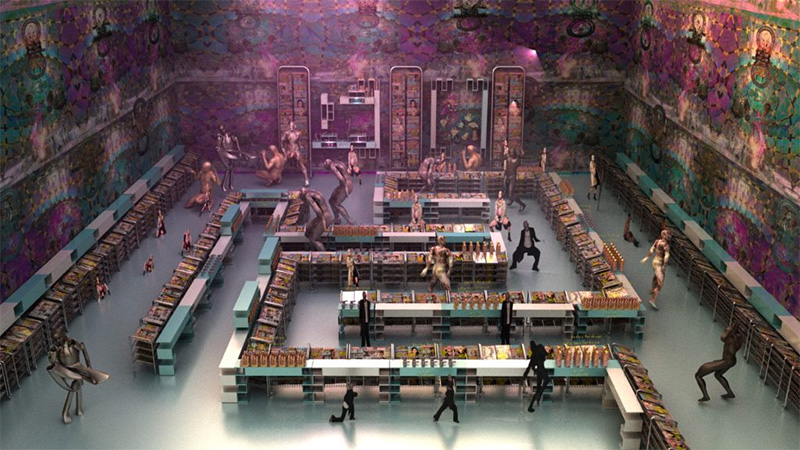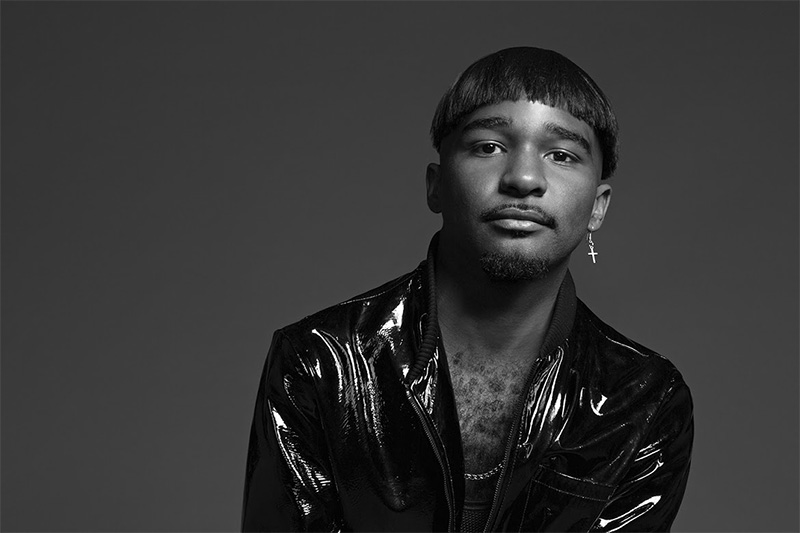
- Source: ARTNEWS
- Author: ANNIE ARMSTRONG
- Date: OCTOBER 04, 2019
- Format: DIGITAL
‘My Palette Is a 40-Gigabyte Hard Drive’:
Jacolby Satterwhite on His New Show at Pioneer Works in Brooklyn

A still from Jacolby Satterwhite’s 2019 virtual reality animation Birds in Paradise.
COURTESY THE ARTIST AND PIONEER WORKS
Jacolby Satterwhite, the multimedia artist who recently collaborated with Solange, has long created intricate virtual worlds that burst with a vibrant vision of queerness. For a new exhibition, titled “You’re at home,” at Pioneer Works in Brooklyn’s Red Hook neighborhood, on view until November 24, Satterwhite is debuting a new work, Birds in Paradise, that puts onlookers into a kind of uncanny valley between the recent past and near future, fabricating a music shop in the same vein as the now shuttered Tower Records but that pulsates with larger-than-life dancing Afro-futuristic figures.
To learn more about the project, ARTnews gave the artist a call.
ARTnews: I read that you’ve been working with your mother’s recordings for about a decade. How does it feel finally to be finished?
Jacolby Satterwhite: It feels amazing. Well, I’ve had the recordings for a decade. I mulled over them and I originally wanted to do this project in the “Reifying Desire” series [which was included in the 2014 Whitney Biennial], but I wasn’t competent enough with the technology. Then I got the commission, and met Nick Weiss. He helped guide me through the softwares Pro Tools and Ableton Live and all the synthesizers. We basically spent the years 2015 through 2018 eight hours a day in the studio creating all the tracks and paring it down into a full-length record.
AN: Has your relationship with the recordings changed since you started on it in 2015?
JS: I’ve had them and I’ve sampled them in projects in a more archaic way. In “Reifying Desire” and in earlier performance videos, the a cappellas were scores for my performances and my live performances. So I used to play them and create a situation out of the lyrics. It was about raw performance in front of an audience. That’s how I used them when I was younger. But then I stopped doing that and just focused on animation and other performance strategies. Then when I found this opportunity through SFMOMA for En Plein Air [a 2016 commission for the museum], I decided to move forward with the project and realize the records as a critical response to the history of music and music genres, and the “objecthood” around music. Like, making a virtual reality album—what does that mean? And how can I use these lyrics as a surrealist prompt for me to move forward with my present ideas.

Jacolby Satterwhite.
MATTHU PLACEK
AN: How does your mother figure into the work?
JS: There wasn’t really a sentimental attachment to her or her recordings or her drawings. They’re really just surrealist devices for me to extrapolate on and find out how to respond to present ideas and present mediums. I consider everyone I collaborate with the same way, [even if] it’s me soliciting 50 people to a green screen to perform so they can be on Blessed Avenue [a video that was the focal point of a 2018 exhibition at Gavin Brown’s Enterprise in New York]. The way I narrativized those bodies together is more of a problem for me to solve than a sentimental attachment to them.
So that’s the kind of paradox, because yes it’s a posthumous project as my mother died in 2016. But at the same time, she’s just another one of the many, intricate, crystallized threads that I use as a resource to build a harmonious network of ideas. It’s more about me being a filmmaker and observing the world and collaging. Instead of oil paint on a tray, my palette is a 40-gigabyte hard drive on a computer.
AN: It’s interesting that you’re incorporating the tactile element of a re-created record store to the project.
JS: The point is that the record exists in virtual reality as well. That you can pick up a VR headset and listen to an album for me brought back the objecthood of something that exists only on streaming devices now. You don’t think about music with CDs and vinyl and 8-tracks anymore. What relationship in this contemporary medium can the listening experience have with an object? That’s virtual reality and VR-headsets. It brings a re-entry back to the music as well, because in order to consume the sound and the visuals, you have to look up, look down, look left, look right to listen to the album. For me, it’s more of an experiment in intersecting mediums.
AN: What was collaborating with Nick Weiss like?
JS: He and I have a really strong sonic relationship. We get what one another wants to hear. He understood my vision sonically more than anyone I could have imagined. I wanted something that related to acid-house and trip-hop and earlier techno that were related to like Bristol, England, and Detroit. I was raised on listening to deep house records that my mother liked. What I love about making music is that it feels very similar to painting or 3-D animation where you have a bunch of tracks and a palette and you have to find a way to consolidate them to build a harmonious vision. It’s the same thing I do when I make a painting or an animation.
AN: What have you been listening to recently?
JS: Cheesy shit! A band called 18 Carat Affair—they sample a lot of weird ’90s commercial music. And I listen to Lana Del Rey’s Norman Fucking Rockwell!
AN: Any song in particular?
JS: I love “Venice Bitch,” “Cinnamon Girl,” and “How to Disappear.”
AN: The music video for her cover of Sublime’s “Doin’ Time” where she strolls through Los Angeles as a 50-foot woman is awesome.
JS: Oh yes. Attack of the 50-Foot Woman was one of my favorite films when I was a kid. I watch that movie like a million times as a kid. She’s so perfect.
AN: Would she be a dream collaboration?
JS: I would work with her in a heartbeat. I love her. I love her so much.

